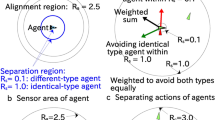Abstract
A boid is a simple multiagent model of animal group behavior. Boid agents communicate locally. I studied a heterogeneous boid model comprised of many agents that are divided into several types. While varying interaction among types of agents, this model generates stable patterns with a symmetric interface among different types of agents. As the number of agents increases and as agent clusters grow larger, this model forms a metastable pattern (i.e., a complex of such stable patterns) that is caused by conflict among the local growths of stable patterns. To avoid metastable patterns, I designed two extended heterogeneous boid models: a two-component boid with noise control and a three-component boid with a type transition of agents. In this paper, I examined how these extended models rearrange agents from metastable patterns into stable patterns. These extended models generate stable patterns regardless of the agent number in a shorter time than the original heterogeneous boid model.









Similar content being viewed by others
References
Nakamura M (2019) Two extensions of heterogeneous boid model. In: Proceedings of the 3rd International Symposium on Swarm Behavior and Bio-Inspired Robotics (SWARM 2019), Okinawa Japan, 20–22 Nov 2019, pp 140–146
Nakamura M, Kurumatani K (2005) A method for designing ant colony models and two examples of its application. Adv Artif Life 3630:530–539 (Springer, LNAI)
Nakamura M (2015) Formation of interfaces in heterogeneous boid models. In: Proceedings of the 1st International Symposium on Swarm Behavior and Bio-Inspired Robotics (SWARM 2015), Kyoto Japan, 28–30 Oct 2015, pp 66–73
Sakai S, Suzuki R (1972) A model of the schooling of fishes (In Japanese). The Institute of Electronics and Communication Engineers of Japan (IECE), MBE
Sakai S, Suzuki R (1973) A model for group structure and its behavior (In Japanese). The Institute of Electronics and Communication Engineers of Japan (IECE), MBE
Reynolds CW (1987) Flocks, herds, and schools: a distributed behavioral model. Comput Graph 21(4):25–34
Couzin I et al (2002) Collective memory and spatial sorting in animal groups. J Theor Biol 218:1–11
Vicsek T et al (1995) Novel type of phase transition in a system of self-driven particles. Phys Rev Lett 75(6):1226–1229
Olfati-Saber R (2006) Flocking for multi-agent dynamics systems: algorithms and theory. IEEE Trans Autom Control 51(3):401–420
Brambilla M et al (2013) Swarm robotics: a review from the swarm engineering perspective. Swarm Intell 7(1):1–41
Vicsek T, Zafeiris A (2012) Collective motion. Phys Rep 517:71–140
Sayama H (2007) Decentralized control and interactive design methods for large-scale heterogeneous self-organizing swarms. Adv Artif Life 4648:675–684 (Springer, LNAI)
Doursat R (2008) Programmable architectures that are complex and self-organized: from morphogenesis to engineering. ALIFE XI, pp 181–188
You SK et al (2009) Collective behaviors of two-component swarms. J Theor Biol 261:494–500
Kumar M et al (2010) Segregation of heterogeneous units in a swarm of robotic agents. IEEE Trans Autom Control 55(3):743–748
Author information
Authors and Affiliations
Corresponding author
Additional information
Publisher's Note
Springer Nature remains neutral with regard to jurisdictional claims in published maps and institutional affiliations.
This work was presented in part at the 3rd International Symposium on Swarm Behavior and Bio-Inspired Robotics (Okinawa, Japan, November 20-22, 2019).
About this article
Cite this article
Nakamura, M. Two extensions of heterogeneous boid model to avoid metastable patterns. Artif Life Robotics 25, 578–587 (2020). https://doi.org/10.1007/s10015-020-00652-0
Received:
Accepted:
Published:
Issue Date:
DOI: https://doi.org/10.1007/s10015-020-00652-0




